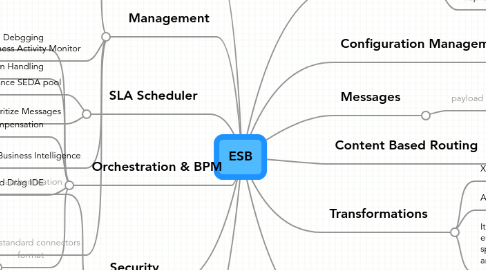
1. Connectors
1.1. transports
1.1.1. SOAP
1.1.2. JMS
1.1.3. File
1.1.4. SMTP
1.1.5. FTP
1.1.6. HTTP
1.1.7. JCA API
1.1.8. Custom API
1.2. protocols
1.2.1. Fixed Length
1.2.2. Header/Block
1.2.3. Tag:Value
1.2.4. API
2. Transactions
2.1. 2pc
2.2. workflow
2.3. durable queues
3. Management
3.1. Manual Management
3.1.1. Live Messages
3.1.1.1. browse
3.1.1.2. create
3.1.1.3. suspend
3.1.1.4. reroute
3.1.2. Queues
3.1.2.1. inspect
3.1.2.2. statistics
3.1.3. Resource Pools
3.1.3.1. resize
3.1.3.2. statistics
3.2. Business Activity Monitor
3.2.1. Key Performance Indicators (KPI)
3.2.2. Know about service dependencies. Able to resolve Root Cause of Failure
3.2.3. Restart Processes
3.3. Business Intelligence
3.3.1. SLA
3.3.1.1. Message Latency
3.3.1.2. Time in Queue
3.3.1.3. Delivery Failure Rate
3.3.1.4. Retry Rate
3.4. standard connectors
3.4.1. SNMP
3.4.2. JMX
4. SLA Scheduler
4.1. Rebalance SEDA pool
4.2. Prioritize Messages
5. Orchestration & BPM
5.1. Debgging
5.2. Exception Handling
5.3. Transaction Compensation
5.3.1. Rollback
5.3.2. Alert
5.3.3. Workflow
5.4. Click and Drag IDE
5.5. format
5.5.1. BPEL
5.5.2. Scripting Language
5.5.3. API
5.5.4. Proprietary Config
6. Security
6.1. authentication
6.1.1. LDAP
6.1.2. JAAS
6.1.3. SAML
6.1.4. GSSS
6.1.5. SASL
6.2. session encryption
6.2.1. SSL
6.2.2. TLS
6.2.3. API
6.3. access control
6.3.1. LDAP
6.3.2. API
6.3.3. Windows ACL
6.3.4. Unix Groups
6.4. auditing
6.5. authorization
6.5.1. XACML
6.5.1.1. SunXACML
6.5.1.1.1. Status : 4- Beta
6.5.1.1.2. License: Sun License
6.5.1.1.3. Description: Open source implementation of the OASIS XACML standard, written in Java
6.5.1.1.4. Sponsored by SUN
6.5.2. P3P
6.5.2.1. Description: Language to describe Privacy Policy for web resources
6.5.3. PONDER
6.5.4. EPAL
6.5.4.1. Description: Not Yet an OASIS standard
6.5.4.2. Detailed Comparison with XACML
6.5.4.3. Sponsored by IBM
7. Messages
7.1. payload
7.1.1. Normalized
7.1.2. Custom
8. Content Based Routing
8.1. XQuery
8.2. API
9. Transformations
9.1. XSLT
9.2. API
9.3. It can uniformly apply business rules, enrichment of the message from other sources, splitting and combining of multiple messages, and the handling of exceptions.
10. Threading
10.1. Sync
10.2. Async
10.3. SEDA
11. Clustering
11.1. Load Balancing
11.2. Failover
11.3. Replication & HA
11.3.1. Total
11.3.2. Partitioned
